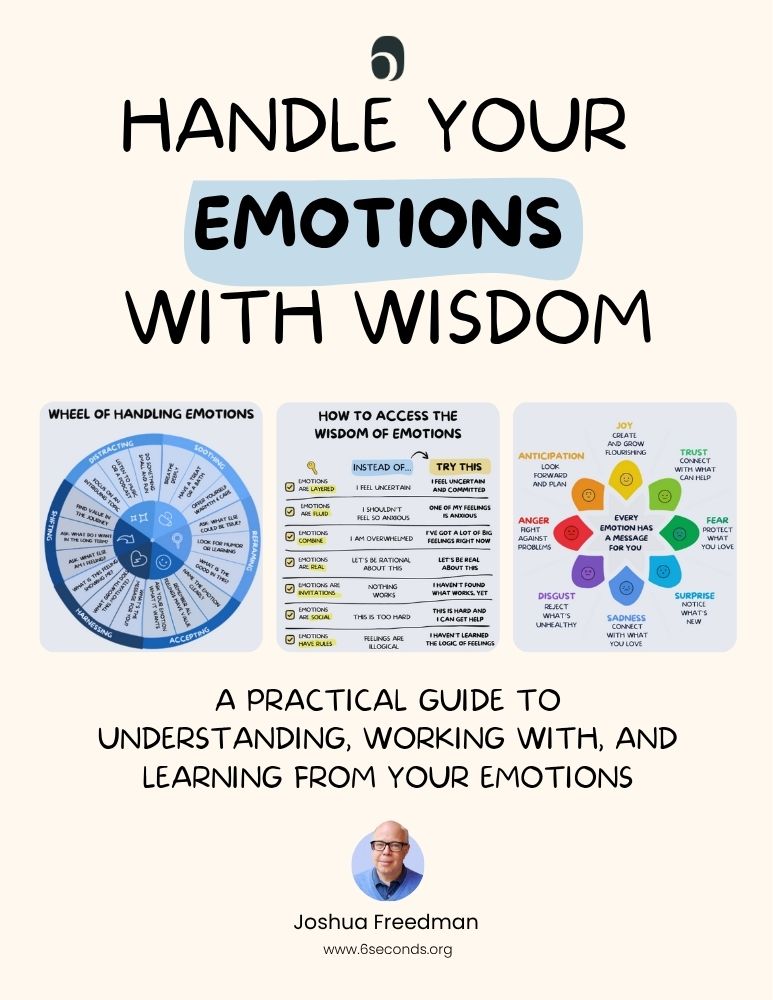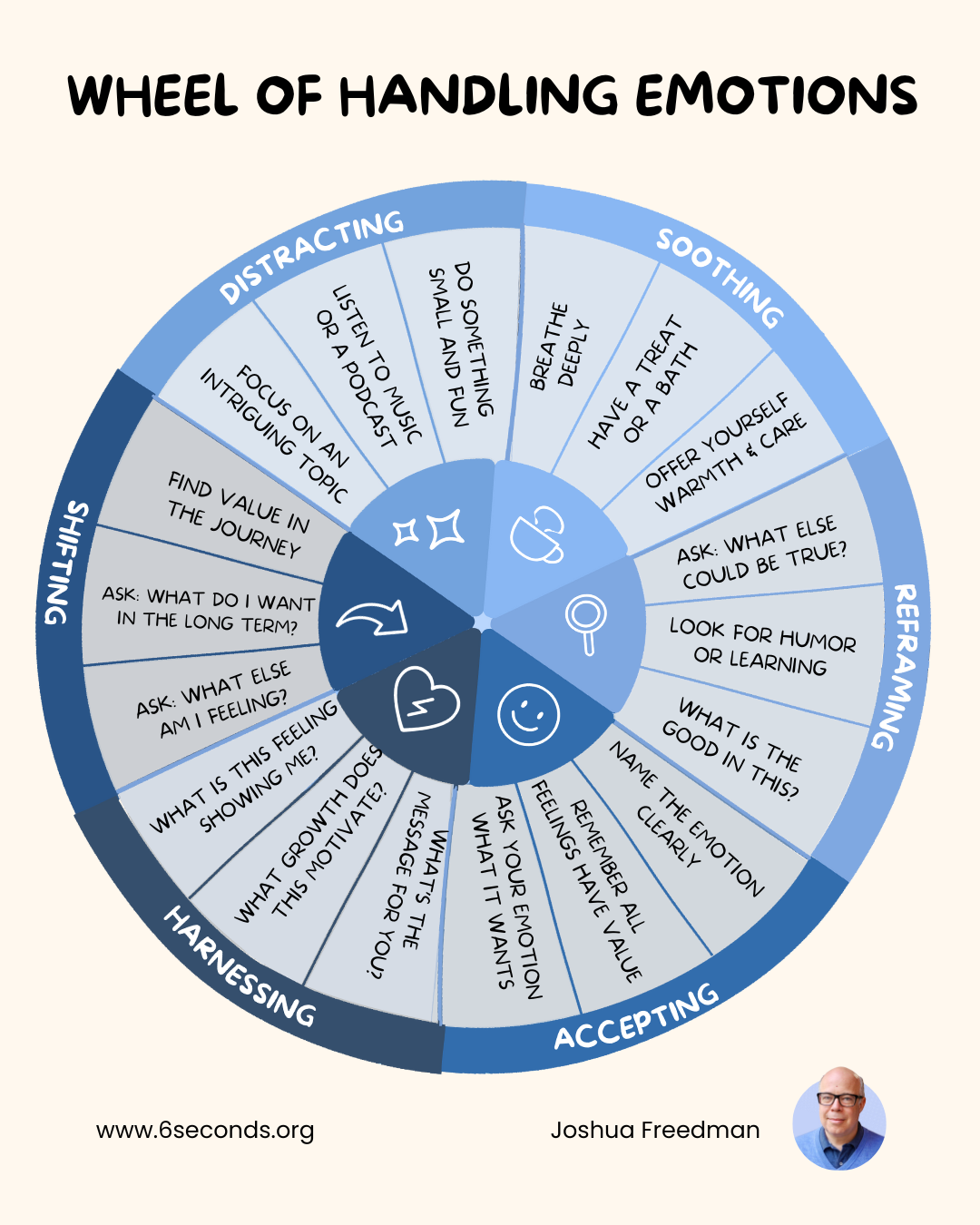Grappling with Challenging Emotions as a Manager: 18 Effective Emotional Intelligence Strategies
On average, you and every person you interact with is experiencing more distress than you did just a few years ago. The heightened level of struggle presents a profound leadership challenge – here’s how to use emotional intelligence to handle difficult emotions, starting with your own.

Uncertainty and anxiety are rising together, and that’s creating additional pressure and challenge on people who lead people. If you’re feeling this pain, you’re not alone:
- The World Economic Forum’s Global Risks Report 2025 finds experts see a near-term environment of heightened geopolitical, economic, and technological uncertainty, with polarization and conflict named as major short-term risks.
- Gallup’s 2025 global emotional health update (144 countries) reports 39% worried and 37% stressed “a lot” the prior day; sadness 26%, anger 22%.
- The 2025 Edelman Trust Barometer highlights deepening fears, polarization, and grievance, with large shares believing institutions are not serving them—conditions associated with anxiety about the future.
- The State of the Heart study reveals a worldwide emotional recession – the latest research is coming soon in Frontiers in Organizational Psychology in a special edition on the Future of Work.
Shutting Down Feelings Doesn’t Work, at Least For Long
Behind these big stats are people like you and me experiencing emotional pain. It can sound like:
- It’s hard to breathe.
- My head is spinning around the same issues over and over, and my heart just keeps racing.
- I can’t think straight.
- I’m just kind of empty.
- I don’t feel like myself anymore.
- I keep pretending everything’s fine, but it’s not.
- I can’t escape from these feelings.
- Everything is getting harder.
- I’m tired of trying to ‘be strong.’
- I don’t even know what I’m feeling anymore.
It’s not just in your head. As I explain in the video, “Why am I anxious about anxiety,” distress (like all emotions) is a whole-body experience. Digestion. Heart. Blood chemistry. Brain. Muscles. Nervous system.
In that state, the obvious reaction is to shut down emotions. This shut down is our body’s usual go-to-strategy for trauma (technically called “dissociation”) –and it helps for a few hours. Other short-term strategies can help, like distraction and self-soothing. But for many of us, the challenges are long-term. Ironically, the short-term strategies often make our situations more complex and challenging when we keep using them. So we need long-term strategies too.
It turns out that the best way to handle difficult emotions might just be to embrace them.
When Your People are Struggling: Your Job as a People-Leader Starts with You
I’m hearing a lot of managers say: “I’m not equipped to handle the emotional challenges my people are bringing to me.” I’m lucky to be an EQ Coach as well as a leader, but even so, I’m also experiencing this stretch.
Most of us managers are not therapists, and even if you are, it’s unlikely you’re treating the people who report to you. So it’s not our job to diagnose or treat our employees. It is our job to support them. Are the core, that’s about being a decent human being, listening, and encouraging.
In some ways, that’s easy. It might sound like,
“It seems like things are really tough right now, do you want to talk?”
“Thanks for letting me know – I’m here whenever you want to talk more.”
“Yah, I’m pretty stressed this week, how about you?”
“If you ever want to go for a walk and talk about how things are going, just let me know”
There are some big obstacles to doing these simple things well:
- When you’re on overload, it seems like there’s no time.
- When you’re emotionally exhausted, it seems like there’s no bandwidth.
- When you’re feeling deeply uncertain, it seems like you can’t support anyone.
As leaders, some people will expect we have the answers or solutions. A big lesson from learning to become an EQ Coach: When you KNOW, it’s not coaching. This applies to being a coaching-leader too: We don’t need to have solutions or answers to emotional challenges.
We do, however, need to fill our own cups. When we’re emotionally drained, it’s incredibly difficult to be patient and supportive. Exhaustion shuts down empathy. We can adapt the famous, “Physician, heal thyself” line (Luke 4:23): Leader, lead yourself.
In this context, it means doing the work to strengthen our own emotional wellbeing.
When the Only Way Out is Through: Embracing Challenging Emotions
Recently, I’ve been grappling with some of these feelings myself. Managing a lot of change, seeing big uncertainties ahead – I’ve been waking up thinking about the problems, not sleeping, then being mad at myself for ruminating.
I tell myself, “Just stop, I don’t want to think about it, and I don’t want to feel this way.” It doesn’t work.
Paradoxically, I’m also in the midst of editing my new book all about making sense of emotions. It’s called Emotion Rules. I came across this excerpt today:
“One of the most surprising functions of emotion is perspective shift.
Feelings like awe, calm, wonder, compassion, or even sorrow can stretch us. They slow us down and ask us to notice. Emotion is the bridge between the moment and the meaning. When we allow ourselves to feel, really feel, we reconnect with the here-and-now and with the bigger picture.
Anxiety shrinks time. Presence expands it.”
I’m reminding myself: Stop pushing away the experience. Feel it – with compassion. Accept it. Learn from it. So I’ve been looking for moments to allow the difficult feelings in, and to say to them: “I know you love me and you’re here to help. What are you trying to tell me?”
Get the high resolution version with the form above, and click here to join the discussion on LinkedIn
When we’re emotionally drained, it’s incredibly difficult to be patient and supportive. Exhaustion shuts down empathy. We can adapt the famous, “Physician, heal thyself” line (Luke 4:23): Leader, lead yourself.
Six Strategies for Challenging Feelings: Use the Right Tool
Decades ago, I was a licensed building contractor, and I remember times when seeing people try to get a screw to sink by hitting it with a hammer. I remember myself trying to get a nail to go in by pounding it with a screw gun. That’s not optimal.
My recent experiences with complicated feelings remind me that I have learned a lot of different tools for working with emotions. I wonder how many of us are trying to “put in nails with a screwdriver” when it comes to our own feelings?
I’ve put together a very short eBook with six strategies to try, with a map of when to try each. I also included two super-useful charts to make sense of emotions.
To soothe your nervous system, try the short-term strategies. When they don’t work, or when the situation goes on for more than a few hours, shift to the longer-term. For each of the strategies below, see 3 specific examples on the graphic, and in the free PDF
DISTRACTING — Temporarily shift your mood by shifting attention.
SOOTHING — Calm your nervous system to make space.
REFRAMING — Start to change the story around the feeling or situation.
There’s a risk of overusing these strategies. Remember, they are good for minutes or hours – maybe days… but not weeks or months! When you’re struggling with longer-term challenges, use longer-term strategies:
ACCEPTING — Stop fighting the feelings open up to the messages
HARNESSING — Get the insight and energy in the emotions (even the tough ones).
SHIFTING** — Move from the immediate moment to what’s next.
These take more work, and time, and when I’m distressed I find these harder to access… but a big part of emotional intelligence is figuring out WHEN to do this kind of deeper work, and getting support (an EQ Coach is a great ally for this, or bring this wheel to your therapist/counselor!)
In the free PDF on this page, you’ll see a simplified version of our emotion wheel and list with more guidance on engaging emotions.
Remember: Keep experimenting, get help if you need it (we all do sometimes!) and use the right tool for your situation.
Use the “right tool for the job.” To soothe your nervous system, try the short-term strategies. When they don’t work, or when the situation goes on for more than a few hours, shift to the longer-term.
For more on how to use emotional intelligence to handle challenges, I recommend:
Transforming Stress
Learn the essential of emotions
- Grappling with Challenging Emotions as a Manager: 18 Effective Emotional Intelligence Strategies - November 3, 2025
- What Are Emotions? Understanding the Science and Meaning Behind How We Feel - October 25, 2025
- Resilience in Recessionary Times: Emotional Intelligence Strategies to Stay Grounded in Escalating Challenge - October 5, 2025


